
On The Border TUCSON, AZ SECTOR

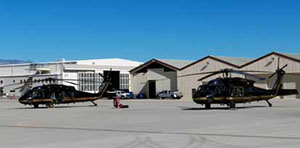
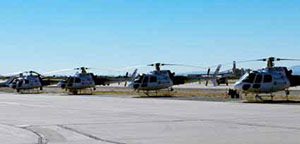
Through the Department of Homeland Security (DHS), U.S. Customs and Border Protection (CPB) is responsible for guarding nearly 7,000 miles of land bordering Canada and Mexico and 2,000 miles of coastal waters surrounding Florida and off the coast of Southern California. The agency also protects 95,000 miles of maritime border in partnership with the U.S. Coast Guard. This is no small task.
U.S. CBP’s top priority is to keep terrorists and their weapons from entering the U.S. While welcoming all legitimate travelers and trade, CBP officers and agents enforce all applicable U.S. laws. CBP works to prevent narcotics, agricultural pests and smuggled goods from entering the country and also identifies and arrests those individuals with outstanding criminal warrants. To assist in this endeavor, enter the Office of Air and Marine (OAM). The OAM is the world’s largest aviation and maritime law enforcement organization. The OAM has more than 1,200 federal agents, 270 aircraft and 280 marine vessels and operates from 80 locations throughout the U.S.
In The Beginning
On May 28, 1924, the Office of the Border Patrol was established. The Customs Air Program was established in 1971. In 1999, the Customs Aviation and Marine Programs merged, creating the Air and Marine Interdiction Division (AMID). On March 1, 2003, AMID transitioned to the DHS under Immigration and Customs Enforcement (ICE), and is renamed the Office of Air and Marine Operations (AMO). On Oct. 1, 2005, the Office of CPB Air was formed, and on Jan. 17, 2006, the CBP Office of Air and Marine was formed.
Mission
The mission of the OAM is to protect U.S. citizens and the nation’s infrastructure through the coordinated use of integrated air and marine forces to detect, interdict and prevent acts of terrorism and the unlawful movement of people, illegal drugs and other contraband toward or across U.S. borders.
Tucson Sector
Today, the Tucson Sector is the busiest sector on the southwest border covering 262 linear miles from the Yuma/Pima County, AZ border, to the New Mexico state line. It is made up of eight stations that are broken down into three corridors. These eight stations are located in Ajo, Casa Grande, Tucson, Nogales, Wilcox, Sonoita, Naco and Douglas.
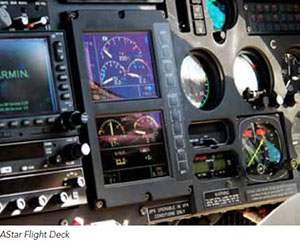 I am at the U.S. CBP Air Support Unit in Tucson, AZ, with Phil Cottam, supervisory aviation maintenance officer. We are going to take a look at the maintenance side of the Air Support Unit’s role in the Tucson Sector.
I am at the U.S. CBP Air Support Unit in Tucson, AZ, with Phil Cottam, supervisory aviation maintenance officer. We are going to take a look at the maintenance side of the Air Support Unit’s role in the Tucson Sector.
HeliMx– How long has the Air Support Unit stationed in Tucson been in operation?
Cottam – The Air Support Unit commenced operations in Tucson in 1972 and I have been here for 13 years.
HeliMx– How many helicopters do you operate and what type are they?
Cottam – We have 14 AStars. Five are B3s and nine are B2s. We also have five UH-60 Blackhawk A models and 3 UH–1H Hueys.
HeliMx– How large an area is your responsibility?
Cottam – We cover one-sixth of the state of Arizona, about 18,000 square miles. This includes nearly the entire Arizona/Mexico border from the Yuma/Pima County Arizona border, to the New Mexico state line, a total distance of 262 miles.
HeliMx– Does your maintenance department have a mission statement?
Cottam – Yes, “to provide unsurpassed fleet wide aircraft maintenance to ensure Office of Air and Marine aircraft are safe, reliable and mission ready. Our dedicated maintenance crews are highly trained, qualified and motivated to support our law enforcement missions guided by integrity, honesty and commitment.”
HeliMx– Does your special mission equipment impact maintenance procedures?
Cottam – Yes. We have a moving map, visual camera, IR camera, downlink and cargo hook capability, and they all have their own ICAs we have to follow.
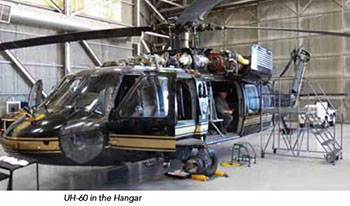 HeliMx– Do you use engine inlet barrier filters?
HeliMx– Do you use engine inlet barrier filters?
Cottam – Yes. Almost all our AStars have them, and since we’ve been using them we’ve have never had to prematurely change an axial compressor. They have proven to make a significant difference operating in the harsh environment of the Arizona desert.
HeliMx– Continuing with the inlet barrier filters, do you find that they have a significant impact on additional maintenance to be performed?
Cottam – There is a little more maintenance to be performed, but it is not excessive. We clean the filters more often than possibly in other environments, but it is well worth the effort. We operate down in the dirt quite a bit and while others may be able to clean their filters every 300 hours, we find that we have to do it every 100 hours. So it’s a little more labor intensive but again, because of where and how we operate, it pays off in the long run. We have found on occasion that we have to clean the filters after 50 hours of operation, but that is the nature of the beast for the missions that we are flying.
HeliMx– Do you deal quite a bit with high and hot operations?
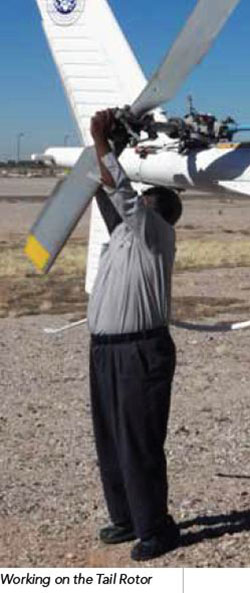 Cottam – Yes to both. In some areas we are flying above 9,000 feet MSL to clear mountainous terrain, and in the summer as we are in the Arizona desert, where a good part of the time it is not uncommon to operate above 120 degrees.
Cottam – Yes to both. In some areas we are flying above 9,000 feet MSL to clear mountainous terrain, and in the summer as we are in the Arizona desert, where a good part of the time it is not uncommon to operate above 120 degrees.
HeliMx– Do the high and hot operations put any undue burdens on your maintenance tasks?
Cottam – Not that I can think of. However, there are some instances when it is really hot, where we may not be able to pass our power check on our AStars. In some instances, we have had to send our engines back to the OEM to have some tweaking done so that we can pass the power checks.
HeliMx– From a flying perspective, under what FAR do you operate?
Cottam – Our normal operating mode is under Part 91. However, we do have a few aircraft that operate under the public use category. The Blackhawks are on loan to us from the Army, so we operate those under Army standards.
HeliMx– From a maintenance perspective, how are you certified as a repair station?
Cottam – We were a Part 145 repair station until two years ago. At that time the office of Homeland Security did a contractor change. We now are with DS2, Defense Support Services, and they are currently working to get their Part 145 repair station license. As you are aware this takes some time, and I believe they are currently about 75 percent along the way to achieving this.
HeliMx– Since they do not have their license yet, who’s doing the repair work for you?
Cottam – Anything that can be done on a 337 form we have an IA sign off. Anything more significant than that, we use an outside vendor. Basically all of our pitot- static and transponder recertification is vendored out.
HeliMx– Since DS2 is doing the maintenance work for the entire Air and Marine Unit, how many maintenance personnel are assigned to your operation?
Cottam – DS2 has around 600 people assigned to the entire Air and Marine Unit throughout the United States. Of that 600, 96 are assigned here to the Tucson sector. Those 96 are assigned as follows: 59 A&P mechanics, nine avionic technicians, eight quality-control personnel, seven parts personnel, seven supervisors, four ground support equipment mechanics and four other support staff. There are only two Customs and Border Protection employees in the mix, myself and Wes Ramirez, aviation maintenance inspector.
HeliMx– How many maintenance shifts are you currently operating?
Cottam – Currently we are operating two shifts and a little bit extra. Although we are flying 24 hours a day, maintenance is performed between 0400 hrs and 0100 hrs daily. We have two shifts, but we do have a few individuals who work some of both as their hours are different by design.
HeliMx– In a typical 30-day period, how many and what type of inspections do you normally perform?
Cottam – On the helicopter side, we always have a 720-hour inspection in work for the UH-60s. That is because we are the hub for the entire country for that inspection. We will do two UH-60 40-hours, and also do two 25-hour inspections on the UH–1s. On the AStar fleet we do between 10 and 12 100-hour inspections and three to four 600-hour inspections. We have a team of mechanics that only do inspections.
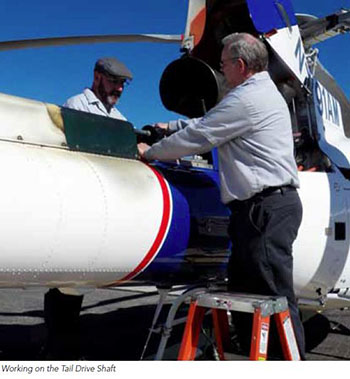
HeliMx– What maintenance tasks are outsourced to an MRO or back to the OEM and why?
Cottam – We hardly outsource anything as we have quite a bit of capability in house. About the only thing we outsource would be the main rotor gearbox and of course engine overhaul.
HeliMx– From start to finish, what’s the procedure for doing a maintenance repair or inspection?
Cottam – Let’s talk about inspections first. The maintenance supervisor will identify all required items, and then QC will load all the tasking into the computer. Then the maintenance supervisor schedules the aircraft and the flight time of that aircraft will be controlled to bring it into maintenance on a certain day. With the aircraft now in maintenance, a crew is assigned to perform the inspection. While the work is being done, there are quality inspections that are performed on the work that is in progress. At the end of the inspection, QC will sign off all the logs and at their prerogative; they can inspect the entire aircraft one last time and then the aircraft is released as airworthy.
Maintenance activities are performed pretty much in the same fashion with one obvious exception. We do not preschedule failures to occur in advance.
HeliMx– Of all the maintenance tasks that you perform, which do you find to be the most labor-intensive and time-consuming?
Cottam – The most time-consuming and labor-intensive maintenance task we do is the 720-hour inspection on the UH-60s. We have a crew of eight A&P mechanics, one quality control person and one lead mechanic working the inspection, and it takes 65 working days to complete. We budget 65 working days to complete the inspection because of extra things that we do during the inspection. Depending on the number of flight hours involved with the UH-60s, we can have as many as three 720-hour inspections going on at the same time. Please remember, we are the hub for the entire country to do these.
HeliMx– That brings up an interesting question that we neglected to ask earlier. How many helicopter flight hours are typically flown in a calendar year?
Cottam – In calendar 2011 we flew a total of 13,400 flight hours. Those are just helicopter flight hours. Of course we have flown many more hours than that, but we are not taking into account our fixed-wing flight hours.
HeliMx– Who performs pre-flight and post-flight inspections on the aircraft?
Cottam – Actual pre-flight and post-flight inspections are performed by the pilot. Our mechanics perform all the servicing functions and check the ADs. The mechanics also give the aircraft a brief look over after every flight, as well as give the aircraft a once over every day after the aircraft’s last flight.
HeliMx– In your day-to-day operations, who has the responsibility for assigning the aircraft to flight operations?
Cottam – That responsibility rests with our maintenance supervisor. In this fashion, he can control the flow of aircraft in and out of inspection status and know which aircraft can be assigned to flight operations. To help in the decision-making process, I give the maintenance supervisor a 24-hour notice of what I anticipate our mission profile to be. This helps him better understand what we need to do and how many aircraft we are going to need to do it. I will also advise him of how many aircraft I want to keep in reserve in case we need to add aircraft to a mission.
HeliMx– Going along with which aircraft are assigned for flight operations, who assigns what maintenance tasks are to be performed on the aircraft?
Cottam – Again, that responsibility lies with the maintenance supervisor.
HeliMx– Describe as best you can what a typical day in the life of the maintenance department is like.
Cottam – First we have to determine just what a typical day is. It is like trying to define normal. What is normal for us will in all probability not be considered normal for a HEMS operator and vice versa.
For us, a typical day starts with the maintenance supervisor calling in the lead mechanics and they discuss what maintenance tasks need to be performed on which aircraft. Then the lead mechanics go out and gather the various maintenance crews and assign the maintenance tasks and aircraft to them. The lead mechanic will also designate which personnel will work the line that shift. By working the line, we mean they will have the responsibility for fueling the aircraft and making sure that they are ready to go out on the next flight.
HeliMx– Earlier you mentioned that you cover about 18,000 square miles of Arizona desert. I know myself, being a resident of Arizona, that the environment is not always hospitable. There are all kinds of critters, rattlesnakes, cacti and other not-so-friendly things that one can bump into. How do you deal with that if an aircraft has to make a landing in the middle of all that and is AOG?
Cottam – First we will liaise with our border patrol agents to help secure the aircraft. They will assign a couple of agents to go out and secure the aircraft and stay with it to be sure nobody gets near it that is not authorized. If it is determined that we may be able to fix it on site, we will send an aircraft with spare parts and mechanics to the scene. We also send an aircraft to bring the aircraft’s pilots back. If that is not doable, if there is more intense maintenance that must be performed, we will send a flatbed truck and a lifting crane and literally lift the aircraft onto the truck and haul it back here. As a matter of fact, we had to do that three times in the last month.
We work very closely with the border patrol agents, as not only are we in a hostile environment as far as terrain, but we are also in a hostile environment as to illegal border crossings, and one never knows what may happen next. When we send mechanics to work on the aircraft, the border patrol agents stay there and provide security for our mechanics while they are working on the aircraft.
HeliMx– Not too long ago, Boeing came out and said that over the next 20 years, the aircraft industry in the United States will need 500,000 A&P mechanics. With that thought in mind, if you were looking to hire mechanics, what skill sets should they have?
Cottam – Because we have an excellent on-the-job training program here, we will actually hire someone straight out of A&P school and show them how we would like them to apply what they have learned. Ideally, we would like to have someone that already has some helicopter experience, but that is not always necessary. The biggest difficulty we’re having is finding qualified people that have experience working with sheet metal and composites. Having those skills sets would be a definite plus.
You asked me what I would be looking for in a new hire, and I just want to remind you that all of our labor here is contracted through DS2 and they are pretty much looking for the same skill set that I just mentioned.
HeliMx– Last question. Is there a safety management system (SMS) being put in place at your facility?
Cottam – Not at the moment, but I understand that our branch manager is pushing Six Sigma concepts along those same lines.
There you have it. Want to work on helicopters and get a good tan in the process? Do you like a dry heat climate? Would you like to work for the world’s largest aviation and marine law enforcement organization? The U.S. CBP’s Office of Air and Marine unit in Tucson, AZ, may be just what you are looking for.
 Phil Cottam is the supervisory aviation maintenance officer at Customs & Border Protection, Tucson Air Branch. He has been an aircraft mechanic for more than 20 years and holds an IA and a private rotorcraft pilot’s license. His maintenance career has included overseas charity mission maintenance, general aviation maintenance, corporate aircraft maintenance and government contracting. During the past 13 years, he has made the Eurocopter AS-350 his specialty. His current position requires oversight of around 100 contract staff taking care of CBP’s aircraft fleet in Arizona.
Phil Cottam is the supervisory aviation maintenance officer at Customs & Border Protection, Tucson Air Branch. He has been an aircraft mechanic for more than 20 years and holds an IA and a private rotorcraft pilot’s license. His maintenance career has included overseas charity mission maintenance, general aviation maintenance, corporate aircraft maintenance and government contracting. During the past 13 years, he has made the Eurocopter AS-350 his specialty. His current position requires oversight of around 100 contract staff taking care of CBP’s aircraft fleet in Arizona.
